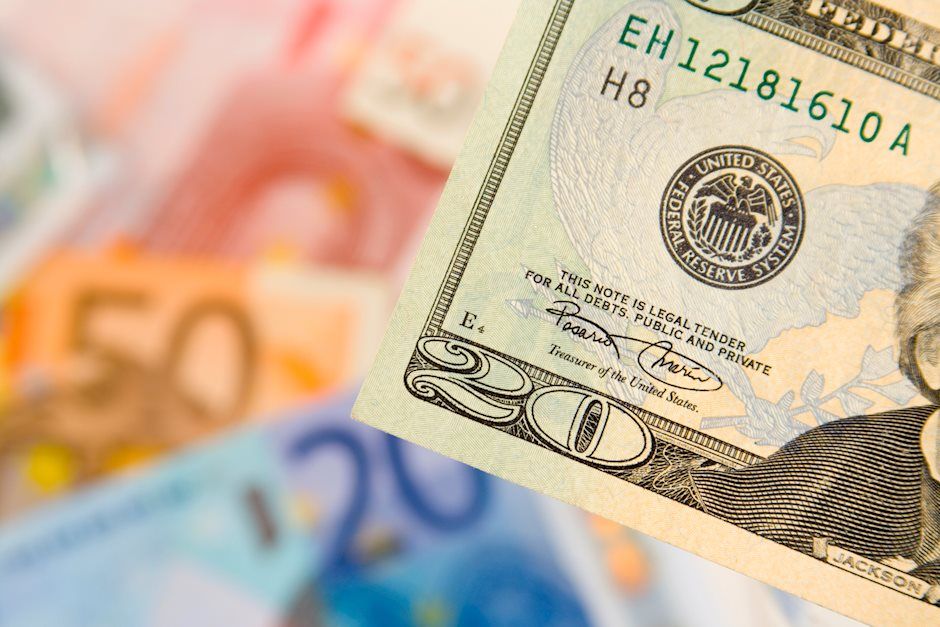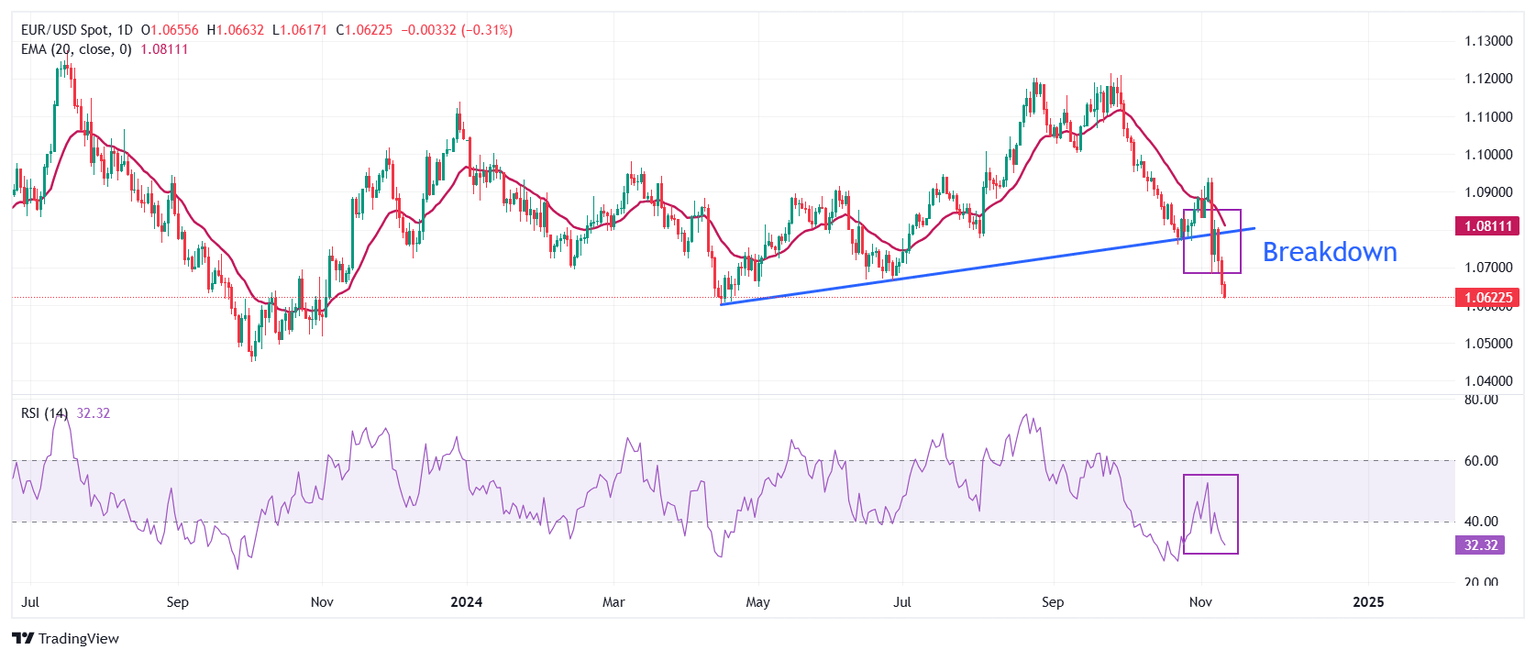EUR/USD tests YTD lows on US-Eurozone trade worries
- EUR/USD declines to near 1.0600 as investors expect that Trump’s protectionist policies will significantly weigh on the Eurozone export sector.
- The ECB is expected to cut interest rates by 50 bps in December.
- Investors shift their focus to the US inflation data for October.

EUR/USD tumbles to near Year-To-Date (YTD) low of 1.0600 in Tuesday’s North American session. The major currency pair continues to face intense selling pressure on heightened concerns over the Eurozone export sector outlook, given that President-elect Donald Trump vowed to raise import tariffs by 10% in his election campaign.
Market experts believe that Trump’s landslide victory is favorable for consumer confidence and business sentiment in the United States (US) but is worrisome for their leading trading partners. Trump's protectionist policies could also lead to a vicious cycle of global trade war, especially with the Eurozone, as Trump mentioned that the euro bloc will "pay a big price" for not buying enough American exports.
Implementing a 10% tariff on all imported goods advocated by Trump would have a negative impact of 0.1% on the European Union’s (EU) Gross Domestic Product (GDP), according to a recent London School of Economics and Political Science paper.
Meanwhile, the collapse of the German three-party coalition after Chancellor Olaf Scholz sacked Finance Minister Christian Linder last week has also been a major cause of weakness in the Euro (EUR). According to a Focus Online report, German Olaf will call a confidence vote on December 18 and the snap election on February 23.
German political uncertainty and potential weakness in the volume of exports are expected to be borne by the European Central Bank (ECB). “It seems a leap of faith at this stage to expect a complete turnaround in the German fiscal position and instead, the onus will be on the European Central Bank to support the eurozone economy, which is expected to cut interest rates by 50 basis points (bps) in December,” analysts at ING said.
In the European session, ECB Governing Council member Olli Rehn said, "If disinflation stays on track, it would make a case for further rate cuts." However, Rehn said that the pace of rate cuts will be data-dependent.
On the economic data front, Eurozone ZEW Survey - Economic Sentiment data for November has come in surprisingly weaker at 12.5 from the prior release of 20.1, which was expected at 20.5. The sentiment indicator data suggests a deviation in the number of optimistic and pessimistic institutional investors.
Daily digest market movers: EUR/USD slumps as US Dollar gains on Trump trades
- EUR/USD is also down by US Dollar’s (USD) strength, which continues to enjoy so-called ‘Trump trades’. The US Dollar Index (DXY), which tracks the Greenback’s value against six major currencies, extends its rally to near 105.90.
- The Greenback rises further on optimism over potential outcomes of Trump’s policies, such as higher labor demand, business investment, and persistent price pressures, which would force the Federal Reserve (Fed) to follow a more gradual policy-easing approach.
- Analysts at JP Morgan have raised its terminal rate forecast to 3.5% from 3%, predicting a steady pace of 25 bps cuts beginning in December. According to the CME FeDwatch tool, the probability of the Fed reducing interest rates by 25 bps to 4.25%-4.50% in December is 65%.
- For more cues about the interest rate path, investors will pay close attention to the US Consumer Price Index (CPI) data for October, which will be released on Wednesday, and commentaries from a string of Fed officials this week, including Fed Chair Jerome Powell.
- Economists expect the headline inflation to have accelerated to 2.6% from 2.4% in September, with core CPI – which excludes volatile food and energy prices – rising steadily by 3.3%.
US Dollar PRICE Today
The table below shows the percentage change of US Dollar (USD) against listed major currencies today. US Dollar was the strongest against the Japanese Yen.
| USD | EUR | GBP | JPY | CAD | AUD | NZD | CHF | |
|---|---|---|---|---|---|---|---|---|
| USD | 0.31% | 0.51% | 0.54% | 0.10% | 0.46% | 0.35% | 0.12% | |
| EUR | -0.31% | 0.21% | 0.23% | -0.21% | 0.15% | 0.04% | -0.16% | |
| GBP | -0.51% | -0.21% | 0.06% | -0.41% | -0.06% | -0.18% | -0.39% | |
| JPY | -0.54% | -0.23% | -0.06% | -0.44% | -0.09% | -0.20% | -0.42% | |
| CAD | -0.10% | 0.21% | 0.41% | 0.44% | 0.35% | 0.25% | 0.02% | |
| AUD | -0.46% | -0.15% | 0.06% | 0.09% | -0.35% | -0.09% | -0.33% | |
| NZD | -0.35% | -0.04% | 0.18% | 0.20% | -0.25% | 0.09% | -0.23% | |
| CHF | -0.12% | 0.16% | 0.39% | 0.42% | -0.02% | 0.33% | 0.23% |
The heat map shows percentage changes of major currencies against each other. The base currency is picked from the left column, while the quote currency is picked from the top row. For example, if you pick the US Dollar from the left column and move along the horizontal line to the Japanese Yen, the percentage change displayed in the box will represent USD (base)/JPY (quote).
Technical Analysis: EUR/USD declines to near 1.0600
EUR/USD extends its losing streak for the third trading day on Tuesday. The major currency pair declines to the YTD low at around 1.0600. The shared currency pair is expected to face more downside, with the 20-day Exponential Moving Average (EMA) turning vertically south near 1.0800.
The return of the 14-day Relative Strength Index (RSI) in the range of 20.00-40.00 indicates bearish momentum gaining traction and adds to evidence of more downside.
Looking down, the pair could decline to near the psychological support of 1.0500 after breaking below 1.0600. On the flip side, the round-level resistance of 1.0700 will be the key barrier for the Euro bulls.
Fed FAQs
Monetary policy in the US is shaped by the Federal Reserve (Fed). The Fed has two mandates: to achieve price stability and foster full employment. Its primary tool to achieve these goals is by adjusting interest rates. When prices are rising too quickly and inflation is above the Fed’s 2% target, it raises interest rates, increasing borrowing costs throughout the economy. This results in a stronger US Dollar (USD) as it makes the US a more attractive place for international investors to park their money. When inflation falls below 2% or the Unemployment Rate is too high, the Fed may lower interest rates to encourage borrowing, which weighs on the Greenback.
The Federal Reserve (Fed) holds eight policy meetings a year, where the Federal Open Market Committee (FOMC) assesses economic conditions and makes monetary policy decisions. The FOMC is attended by twelve Fed officials – the seven members of the Board of Governors, the president of the Federal Reserve Bank of New York, and four of the remaining eleven regional Reserve Bank presidents, who serve one-year terms on a rotating basis.
In extreme situations, the Federal Reserve may resort to a policy named Quantitative Easing (QE). QE is the process by which the Fed substantially increases the flow of credit in a stuck financial system. It is a non-standard policy measure used during crises or when inflation is extremely low. It was the Fed’s weapon of choice during the Great Financial Crisis in 2008. It involves the Fed printing more Dollars and using them to buy high grade bonds from financial institutions. QE usually weakens the US Dollar.
Quantitative tightening (QT) is the reverse process of QE, whereby the Federal Reserve stops buying bonds from financial institutions and does not reinvest the principal from the bonds it holds maturing, to purchase new bonds. It is usually positive for the value of the US Dollar.
Author

Sagar Dua
FXStreet
Sagar Dua is associated with the financial markets from his college days. Along with pursuing post-graduation in Commerce in 2014, he started his markets training with chart analysis.


















